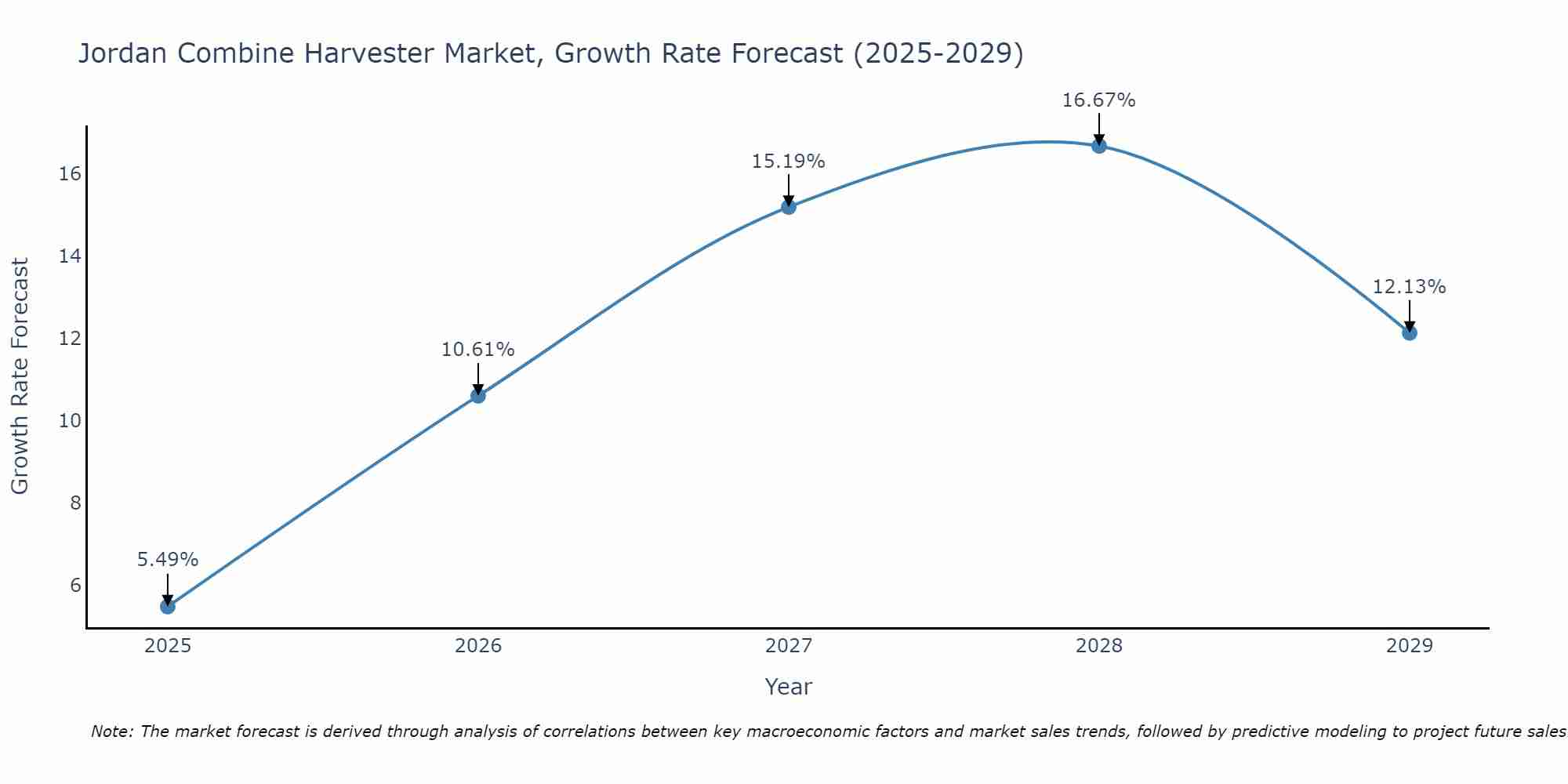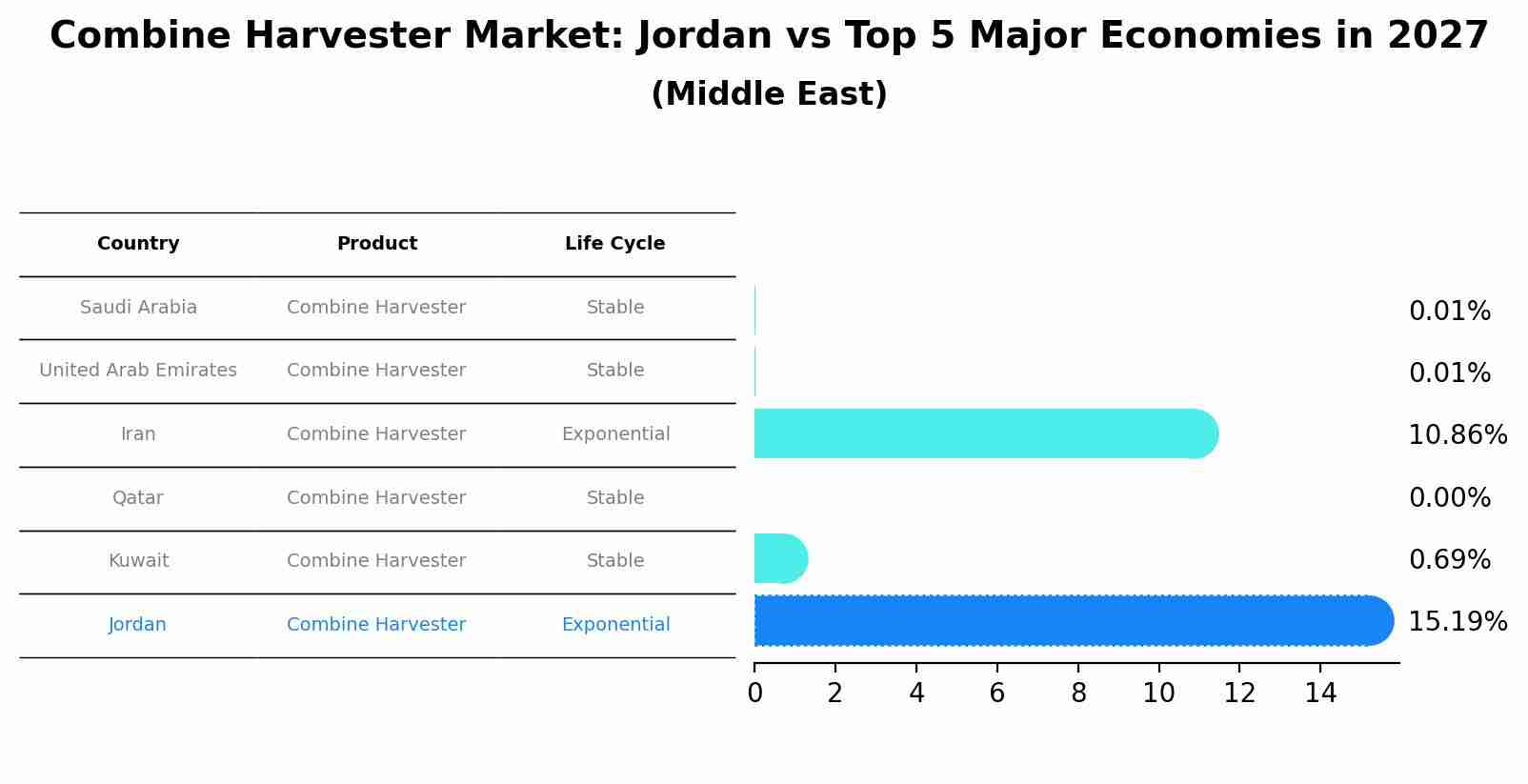Jordan Combine Harvester Market (2025-2031) Outlook | Forecast, Analysis, Trends, Share, Revenue, Companies, Growth, Industry, Size & Value
| Product Code: ETC428742 | Publication Date: Oct 2022 | Updated Date: Aug 2025 | Product Type: Market Research Report | |
| Publisher: 6Wresearch | Author: Shubham Padhi | No. of Pages: 75 | No. of Figures: 35 | No. of Tables: 20 |
Jordan Combine Harvester Market Size Growth Rate
The Jordan Combine Harvester Market is projected to witness mixed growth rate patterns during 2025 to 2029. Growth accelerates to 16.67% in 2028, following an initial rate of 5.49%, before easing to 12.13% at the end of the period.

Combine Harvester Market: Jordan vs Top 5 Major Economies in 2027 (Middle East)
By 2027, the Combine Harvester market in Jordan is anticipated to reach a growth rate of 15.19%, as part of an increasingly competitive Middle East region, where Saudi Arabia remains at the forefront, supported by United Arab Emirates, Iran, Qatar and Kuwait, driving innovations and market adoption across sectors.

Jordan Combine Harvester Market Overview
Jordan combine harvester market is growing as the country seeks to improve agricultural productivity and efficiency. Combine harvesters, which combine the tasks of reaping, threshing, and winnowing into a single process, are becoming more popular among Jordan farmers. The market is driven by the need to modernize agricultural practices, reduce labor costs, and increase crop yields. Government initiatives and subsidies aimed at promoting mechanized farming also play a significant role in market growth.
Drivers of the market
The combine harvester market in Jordan is driven by factors such as increasing mechanization of agricultural processes, growing adoption of modern farming techniques, and government initiatives to improve agricultural productivity and food security. Farmers are increasingly investing in combine harvesters to streamline harvesting operations and maximize crop yields.
Challenges of the market
The Jordan Combine Harvester Market faces challenges such as high initial investment costs and limited access to affordable financing options for farmers. Additionally, the market is impacted by fluctuating agricultural commodity prices, which affect farmers` purchasing decisions. There are also issues related to the availability of spare parts and maintenance services, which can hinder the efficient use of combine harvesters.
Government Policy of the market
The Ministry of Agriculture supports the modernization of agricultural practices through subsidies and financial incentives for farmers purchasing combine harvesters. Government policies aim to increase agricultural productivity, reduce post-harvest losses, and promote the adoption of modern farming equipment to ensure food security and economic sustainability.
Key Highlights of the Report:
- Jordan Combine Harvester Market Outlook
- Market Size of Jordan Combine Harvester Market, 2024
- Forecast of Jordan Combine Harvester Market, 2031
- Historical Data and Forecast of Jordan Combine Harvester Revenues & Volume for the Period 2021-2031
- Jordan Combine Harvester Market Trend Evolution
- Jordan Combine Harvester Market Drivers and Challenges
- Jordan Combine Harvester Price Trends
- Jordan Combine Harvester Porter's Five Forces
- Jordan Combine Harvester Industry Life Cycle
- Historical Data and Forecast of Jordan Combine Harvester Market Revenues & Volume By Cutting Width for the Period 2021-2031
- Historical Data and Forecast of Jordan Combine Harvester Market Revenues & Volume By Small Size Combine Harvester for the Period 2021-2031
- Historical Data and Forecast of Jordan Combine Harvester Market Revenues & Volume By Large Size Combine Harvester for the Period 2021-2031
- Historical Data and Forecast of Jordan Combine Harvester Market Revenues & Volume By Type for the Period 2021-2031
- Historical Data and Forecast of Jordan Combine Harvester Market Revenues & Volume By Wheel Type Combine Harvester for the Period 2021-2031
- Historical Data and Forecast of Jordan Combine Harvester Market Revenues & Volume By Crawler Type Combine Harvester for the Period 2021-2031
- Historical Data and Forecast of Jordan Combine Harvester Market Revenues & Volume By Power Source for the Period 2021-2031
- Historical Data and Forecast of Jordan Combine Harvester Market Revenues & Volume By Tractor Pulled/PTO Powered Combine Harvester for the Period 2021-2031
- Historical Data and Forecast of Jordan Combine Harvester Market Revenues & Volume By Self-Propelled Combine Harvester for the Period 2021-2031
- Jordan Combine Harvester Import Export Trade Statistics
- Market Opportunity Assessment By Cutting Width
- Market Opportunity Assessment By Type
- Market Opportunity Assessment By Power Source
- Jordan Combine Harvester Top Companies Market Share
- Jordan Combine Harvester Competitive Benchmarking By Technical and Operational Parameters
- Jordan Combine Harvester Company Profiles
- Jordan Combine Harvester Key Strategic Recommendations
Frequently Asked Questions About the Market Study (FAQs):
1 Executive Summary |
2 Introduction |
2.1 Key Highlights of the Report |
2.2 Report Description |
2.3 Market Scope & Segmentation |
2.4 Research Methodology |
2.5 Assumptions |
3 Jordan Combine Harvester Market Overview |
3.1 Jordan Country Macro Economic Indicators |
3.2 Jordan Combine Harvester Market Revenues & Volume, 2021 & 2031F |
3.3 Jordan Combine Harvester Market - Industry Life Cycle |
3.4 Jordan Combine Harvester Market - Porter's Five Forces |
3.5 Jordan Combine Harvester Market Revenues & Volume Share, By Cutting Width, 2021 & 2031F |
3.6 Jordan Combine Harvester Market Revenues & Volume Share, By Type, 2021 & 2031F |
3.7 Jordan Combine Harvester Market Revenues & Volume Share, By Power Source, 2021 & 2031F |
4 Jordan Combine Harvester Market Dynamics |
4.1 Impact Analysis |
4.2 Market Drivers |
4.2.1 Increasing demand for efficient agricultural machinery in Jordan |
4.2.2 Government initiatives to modernize and mechanize the agriculture sector |
4.2.3 Growing awareness among farmers about the benefits of using combine harvesters |
4.3 Market Restraints |
4.3.1 High initial investment required for purchasing combine harvesters |
4.3.2 Lack of skilled operators for operating and maintaining the machinery |
4.3.3 Limited availability of financing options for farmers |
5 Jordan Combine Harvester Market Trends |
6 Jordan Combine Harvester Market, By Types |
6.1 Jordan Combine Harvester Market, By Cutting Width |
6.1.1 Overview and Analysis |
6.1.2 Jordan Combine Harvester Market Revenues & Volume, By Cutting Width, 2021-2031F |
6.1.3 Jordan Combine Harvester Market Revenues & Volume, By Small Size Combine Harvester, 2021-2031F |
6.1.4 Jordan Combine Harvester Market Revenues & Volume, By Large Size Combine Harvester, 2021-2031F |
6.2 Jordan Combine Harvester Market, By Type |
6.2.1 Overview and Analysis |
6.2.2 Jordan Combine Harvester Market Revenues & Volume, By Wheel Type Combine Harvester, 2021-2031F |
6.2.3 Jordan Combine Harvester Market Revenues & Volume, By Crawler Type Combine Harvester, 2021-2031F |
6.3 Jordan Combine Harvester Market, By Power Source |
6.3.1 Overview and Analysis |
6.3.2 Jordan Combine Harvester Market Revenues & Volume, By Tractor Pulled/PTO Powered Combine Harvester, 2021-2031F |
6.3.3 Jordan Combine Harvester Market Revenues & Volume, By Self-Propelled Combine Harvester, 2021-2031F |
7 Jordan Combine Harvester Market Import-Export Trade Statistics |
7.1 Jordan Combine Harvester Market Export to Major Countries |
7.2 Jordan Combine Harvester Market Imports from Major Countries |
8 Jordan Combine Harvester Market Key Performance Indicators |
8.1 Average annual increase in acreage harvested using combine harvesters |
8.2 Percentage of farmers using combine harvesters compared to traditional methods |
8.3 Adoption rate of new combine harvester technologies and features |
8.4 Average age of combine harvester fleet in Jordan |
8.5 Training and certification levels of combine harvester operators |
9 Jordan Combine Harvester Market - Opportunity Assessment |
9.1 Jordan Combine Harvester Market Opportunity Assessment, By Cutting Width, 2021 & 2031F |
9.2 Jordan Combine Harvester Market Opportunity Assessment, By Type, 2021 & 2031F |
9.3 Jordan Combine Harvester Market Opportunity Assessment, By Power Source, 2021 & 2031F |
10 Jordan Combine Harvester Market - Competitive Landscape |
10.1 Jordan Combine Harvester Market Revenue Share, By Companies, 2024 |
10.2 Jordan Combine Harvester Market Competitive Benchmarking, By Operating and Technical Parameters |
11 Company Profiles |
12 Recommendations |
13 Disclaimer |
- Single User License$ 1,995
- Department License$ 2,400
- Site License$ 3,120
- Global License$ 3,795
Search
Thought Leadership and Analyst Meet
Our Clients
Related Reports
- Germany Breakfast Food Market (2026-2032) | Industry, Share, Growth, Size, Companies, Value, Analysis, Revenue, Trends, Forecast & Outlook
- Australia Briquette Market (2025-2031) | Growth, Size, Revenue, Forecast, Analysis, Trends, Value, Share, Industry & Companies
- Vietnam System Integrator Market (2025-2031) | Size, Companies, Analysis, Industry, Value, Forecast, Growth, Trends, Revenue & Share
- ASEAN and Thailand Brain Health Supplements Market (2025-2031) | Strategy, Consumer Insights, Analysis, Investment Trends, Opportunities, Growth, Size, Share, Industry, Revenue, Segments, Value, Segmentation, Supply, Forecast, Restraints, Outlook, Competition, Drivers, Trends, Demand, Pricing Analysis, Competitive, Strategic Insights, Companies, Challenges
- ASEAN Bearings Market (2025-2031) | Strategy, Consumer Insights, Analysis, Investment Trends, Opportunities, Growth, Size, Share, Industry, Revenue, Segments, Value, Segmentation, Supply, Forecast, Restraints, Outlook, Competition, Drivers, Trends, Demand, Pricing Analysis, Competitive, Strategic Insights, Companies, Challenges
- Europe Flooring Market (2025-2031) | Outlook, Share, Industry, Trends, Forecast, Companies, Revenue, Size, Analysis, Growth & Value
- Saudi Arabia Manlift Market (2025-2031) | Outlook, Size, Growth, Trends, Companies, Industry, Revenue, Value, Share, Forecast & Analysis
- Uganda Excavator, Crane, and Wheel Loaders Market (2025-2031) | Strategy, Consumer Insights, Analysis, Investment Trends, Opportunities, Growth, Size, Share, Industry, Revenue, Segments, Value, Segmentation, Supply, Forecast, Restraints, Outlook, Competition, Drivers, Trends, Demand, Pricing Analysis, Competitive, Strategic Insights, Companies, Challenges
- Rwanda Excavator, Crane, and Wheel Loaders Market (2025-2031) | Strategy, Consumer Insights, Analysis, Investment Trends, Opportunities, Growth, Size, Share, Industry, Revenue, Segments, Value, Segmentation, Supply, Forecast, Restraints, Outlook, Competition, Drivers, Trends, Demand, Pricing Analysis, Competitive, Strategic Insights, Companies, Challenges
- Kenya Excavator, Crane, and Wheel Loaders Market (2025-2031) | Strategy, Consumer Insights, Analysis, Investment Trends, Opportunities, Growth, Size, Share, Industry, Revenue, Segments, Value, Segmentation, Supply, Forecast, Restraints, Outlook, Competition, Drivers, Trends, Demand, Pricing Analysis, Competitive, Strategic Insights, Companies, Challenges
Industry Events and Analyst Meet
Whitepaper
- Middle East & Africa Commercial Security Market Click here to view more.
- Middle East & Africa Fire Safety Systems & Equipment Market Click here to view more.
- GCC Drone Market Click here to view more.
- Middle East Lighting Fixture Market Click here to view more.
- GCC Physical & Perimeter Security Market Click here to view more.
6WResearch In News
- Doha a strategic location for EV manufacturing hub: IPA Qatar
- Demand for luxury TVs surging in the GCC, says Samsung
- Empowering Growth: The Thriving Journey of Bangladesh’s Cable Industry
- Demand for luxury TVs surging in the GCC, says Samsung
- Video call with a traditional healer? Once unthinkable, it’s now common in South Africa
- Intelligent Buildings To Smooth GCC’s Path To Net Zero


















